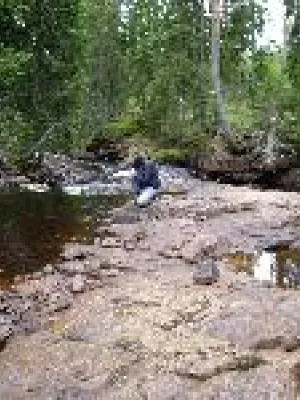
Sanna Alwmark
Postdoctoral fellow

The Wabar impact craters, Saudi Arabia, revisited
Author
Summary, in English
The very young Wabar craters formed by impact of an iron meteorite and are known to the scientific community since 1933. We describe field observations made during a visit to the Wabar impact site, provide analytical data on the material collected, and combine these data with poorly known information discovered during the recovery of the largest meteorites. During our visit in March 2008, only two craters (Philby-B and 11m) were visible; Philby-A was completely covered by sand. Mapping of the ejecta field showed that the outcrops are strongly changing over time. Combining information from different visitors with our own and satellite images, we estimate that the large seif dunes over the impact site migrate by approximately 1.0-2.0myr(-1) southward. Shock lithification took place even at the smallest, 11m crater, but planar fractures (PFs) and undecorated planar deformation features (PDFs), as well as coesite and stishovite, have only been found in shock-lithified material from the two larger craters. Shock-lithified dune sand material shows perfectly preserved sedimentary structures including cross-bedding and animal burrows as well as postimpact structures such as open fractures perpendicular to the bedding, slickensides, and radiating striation resembling shatter cones. The composition of all impact melt glasses can be explained as mixtures of aeolian sand and iron meteorite. We observed a partial decoupling of Fe and Ni in the black impact glass, probably due to partitioning of Ni into unoxidized metal droplets. The absence of a Ca-enriched component demonstrates that the craters did not penetrate the bedrock below the sand sheet, which has an estimated thickness of 20-30m.
Department/s
- Lithosphere and Biosphere Science
Publishing year
2013
Language
English
Pages
2000-2014
Publication/Series
Meteoritics and Planetary Science
Volume
48
Issue
10
Document type
Journal article
Publisher
Wiley-Blackwell
Topic
- Geology
Status
Published
ISBN/ISSN/Other
- ISSN: 1086-9379

